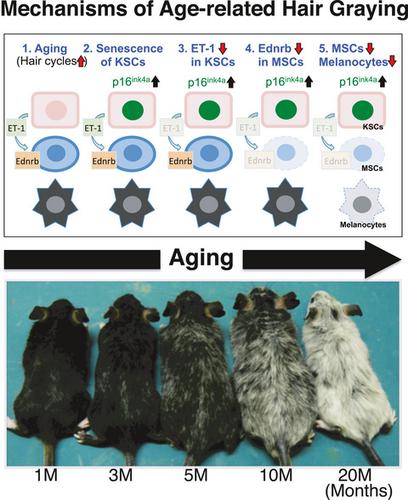当前位置:
X-MOL 学术
›
Aging Cell
›
论文详情
Our official English website, www.x-mol.net, welcomes your feedback! (Note: you will need to create a separate account there.)
Hair graying with aging in mice carrying oncogenic RET
Aging Cell ( IF 7.8 ) Pub Date : 2020-11-07 , DOI: 10.1111/acel.13273 Machiko Iida 1, 2 , Akira Tazaki 1 , Ichiro Yajima 1, 2 , Nobutaka Ohgami 1, 2 , Nobuhiko Taguchi 2, 3 , Yuji Goto 2 , Mayuko Y Kumasaka 1, 2 , Armelle Prévost-Blondel 4 , Michihiro Kono 5 , Masashi Akiyama 5 , Masahide Takahashi 6 , Masashi Kato 1, 2
Aging Cell ( IF 7.8 ) Pub Date : 2020-11-07 , DOI: 10.1111/acel.13273 Machiko Iida 1, 2 , Akira Tazaki 1 , Ichiro Yajima 1, 2 , Nobutaka Ohgami 1, 2 , Nobuhiko Taguchi 2, 3 , Yuji Goto 2 , Mayuko Y Kumasaka 1, 2 , Armelle Prévost-Blondel 4 , Michihiro Kono 5 , Masashi Akiyama 5 , Masahide Takahashi 6 , Masashi Kato 1, 2
Affiliation

|
Hair graying is a representative sign of aging in animals and humans. However, the mechanism for hair graying with aging remains largely unknown. In this study, we found that the microscopic appearance of hair follicles without melanocyte stem cells (MSCs) and descendant melanocytes as well as macroscopic appearances of hair graying in RET‐transgenic mice carrying RET oncogene (RET‐mice) are in accordance with previously reported results for hair graying in humans. Therefore, RET‐mice could be a novel model mouse line for age‐related hair graying. We further showed hair graying with aging in RET‐mice associated with RET‐mediated acceleration of hair cycles, increase of senescent follicular keratinocyte stem cells (KSCs), and decreased expression levels of endothelin‐1 (ET‐1) in bulges, decreased endothelin receptor B (Ednrb) expression in MSCs, resulting in a decreased number of follicular MSCs. We then showed that hair graying in RET‐mice was accelerated by congenitally decreased Ednrb expression in MSCs in heterozygously Ednrb‐deleted RET‐mice [Ednrb(+/−);RET‐mice]. We finally partially confirmed common mechanisms of hair graying with aging in mice and humans. Taken together, our results suggest that age‐related dysfunction between ET‐1 in follicular KSCs and endothelin receptor B (Ednrb) in follicular MSCs via cumulative hair cycles is correlated with hair graying with aging.
中文翻译:

携带致癌 RET 的小鼠的头发随着衰老而变白
头发变白是动物和人类衰老的典型标志。然而,随着年龄的增长头发变白的机制在很大程度上仍然未知。在这项研究中,我们发现在携带RET 的RET转基因小鼠中,没有黑色素细胞干细胞 (MSCs) 和后代黑色素细胞的毛囊的微观外观以及头发变白的宏观外观。致癌基因(RET-小鼠)与先前报道的人类头发变白的结果一致。因此,RET-小鼠可能是一种新型的与年龄相关的头发变白的模型小鼠品系。我们进一步发现 RET 小鼠的头发随着年龄的增长而变白与 RET 介导的毛发周期加速、衰老的滤泡角质形成细胞干细胞 (KSC) 的增加以及凸起中内皮素-1 (ET-1) 的表达水平降低、内皮素降低MSCs 中受体 B (Ednrb) 的表达,导致滤泡 MSCs 的数量减少。然后我们发现,在杂合性 Ednrb 缺失的 RET 小鼠中,MSCs 中的 Ednrb 表达先天性降低,从而加速了 RET 小鼠的头发变白 [Ednrb(+/-);RET-小鼠]。我们最终部分证实了小鼠和人类头发随着衰老而变白的常见机制。综合起来,
更新日期:2020-11-23
中文翻译:

携带致癌 RET 的小鼠的头发随着衰老而变白
头发变白是动物和人类衰老的典型标志。然而,随着年龄的增长头发变白的机制在很大程度上仍然未知。在这项研究中,我们发现在携带RET 的RET转基因小鼠中,没有黑色素细胞干细胞 (MSCs) 和后代黑色素细胞的毛囊的微观外观以及头发变白的宏观外观。致癌基因(RET-小鼠)与先前报道的人类头发变白的结果一致。因此,RET-小鼠可能是一种新型的与年龄相关的头发变白的模型小鼠品系。我们进一步发现 RET 小鼠的头发随着年龄的增长而变白与 RET 介导的毛发周期加速、衰老的滤泡角质形成细胞干细胞 (KSC) 的增加以及凸起中内皮素-1 (ET-1) 的表达水平降低、内皮素降低MSCs 中受体 B (Ednrb) 的表达,导致滤泡 MSCs 的数量减少。然后我们发现,在杂合性 Ednrb 缺失的 RET 小鼠中,MSCs 中的 Ednrb 表达先天性降低,从而加速了 RET 小鼠的头发变白 [Ednrb(+/-);RET-小鼠]。我们最终部分证实了小鼠和人类头发随着衰老而变白的常见机制。综合起来,



























 京公网安备 11010802027423号
京公网安备 11010802027423号